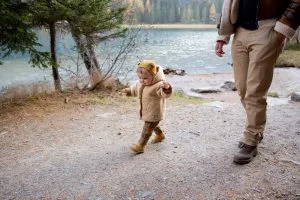 The momentous journey of a baby’s first steps is a milestone that fills every parent’s heart with pride and joy. Those shaky, uncertain movements are a testament to a child’s growth and developmental achievements. Encouraging a baby to walk is not merely about witnessing an endearing spectacle; it’s a crucial physical and cognitive development phase. As parents, caregivers, and guardians, understanding how to support and foster this transition from crawling to walking is critically important.
The momentous journey of a baby’s first steps is a milestone that fills every parent’s heart with pride and joy. Those shaky, uncertain movements are a testament to a child’s growth and developmental achievements. Encouraging a baby to walk is not merely about witnessing an endearing spectacle; it’s a crucial physical and cognitive development phase. As parents, caregivers, and guardians, understanding how to support and foster this transition from crawling to walking is critically important.
In this article, we will explore how to encourage a baby to walk, offering insights into the importance of this milestone and providing valuable tips to ensure that your little one takes their first steps confidently and securely into a world full of exploration and discovery. So, let’s take those initial strides together toward empowering your baby’s development and independence.
What Age Do Babies Walk?
Many new parents wonder, “At what age do babies start walking?” The reality is that each baby is unique. Though there’s no exact age, babies generally begin walking anywhere between eight to 18 months.
Parents and caregivers eagerly await the moment a baby starts to walk. This significant milestone symbolizes a child’s journey from infancy to becoming a toddler.
While most babies venture their first steps between nine and 12 months, it’s not uncommon to see some start as early as eight months or as late as 16 to 17 months. Such variations are entirely normal and can be influenced by factors like genetics, muscle strength, and overall development.
As a parent or caregiver, providing a safe and supportive environment for your baby to explore and practice their newfound mobility is essential. Parents learn how to encourage their baby to walk by offering their hands for support, using push toys to help the baby stand, and creating a space free from hazards.
If you have concerns about your baby’s development or if they haven’t started walking by 18 months, it’s a good idea to consult with a pediatrician to rule out any underlying issues. Remember that every child is unique; the most important thing is supporting and celebrating their journey towards this exciting milestone.
Stages of Learning How to Walk
The journey to walking begins long before those first steps. Babies typically progress through a series of developmental stages, including crawling, scooting, and cruising, before attempting to walk independently. These stages help babies build the muscle strength, balance, and coordination required for walking.
Crawling
Encouraging a baby to walk starts with the crawling phase. This is often the first step towards a child’s independent mobility. It typically begins when a baby is around six to 10 months old. During this stage, infants develop the strength and coordination needed to support their body weight on their hands and knees. They gradually learn to synchronize their limb movement, propelling themselves forward or backward. Crawling helps babies explore their environment, build upper body strength, and refine their motor skills.
As a parent or caregiver, you can encourage crawling with toys to help a baby stand and walk. Create a safe space for your child to practice. Placing enticing toys just beyond their reach can motivate them to move and explore. It’s also essential to baby-proof your home to ensure that your little explorer can roam freely without encountering hazards.
Scooting
Scooting is a stage that often follows crawling and is characterized by babies using their bottom to move across the floor. This unique method of locomotion can appear as a seated shuffle or sliding on their belly while pushing with their legs. Scooting usually occurs around eight to 12 months of age.
During the scooting phase, babies strengthen their leg muscles and enhance their sense of balance. To support this stage in how to help your baby walk, caregivers can provide opportunities for the baby to scoot by placing soft pillows on the floor to cushion their movements. You can also offer a variety of textured surfaces to encourage scooting, as the tactile sensation is appealing to little ones.
Cruising
The next phase in how to encourage a baby to walk is cruising. Cruising is the last stage before independent walking and typically occurs around nine to 12 months of age. During this phase, babies use furniture or other stable objects as support to move around while standing. They take small steps while holding onto the edge of a couch, coffee table, or other items. Cruising helps babies build leg strength and balance as they prepare for that exciting moment when they take their first unaided steps.
When considering how to get your baby to walk, creating a safe environment free of obstacles at home is vital. Encourage exploration by letting your baby hold onto furniture and shower them with praise and encouragement to instill confidence. As they prepare for that transition, opt for soft, supportive footwear.
How to Help a Baby Walk
 Watching their first steps is an exciting moment in how to teach a baby to walk. While learning to walk occurs naturally, babies benefit from physical support and encouragement as they build the strength and balance needed for independent walking. Here are some effective tips to understand how to encourage a baby to walk by physically assisting their instincts to move and explore.
Watching their first steps is an exciting moment in how to teach a baby to walk. While learning to walk occurs naturally, babies benefit from physical support and encouragement as they build the strength and balance needed for independent walking. Here are some effective tips to understand how to encourage a baby to walk by physically assisting their instincts to move and explore.
Understanding how to teach a baby to walk is a journey filled with excitement and anticipation for parents. Although walking is a natural developmental milestone, babies can benefit from added physical support and motivation. To further this development, consider these helpful strategies.
Cruise Around the Furniture
Cruising around furniture is a significant step in the journey to walking. As previously noted, babies typically start cruising around nine to 12 months. To help them, arrange furniture like sofas, coffee tables, or sturdy chairs to allow the baby to hold on and move from one piece to another. This positioning provides essential support and balance as they practice standing and taking small steps.
Support Their Trunk
A critical tip for anyone wondering how to encourage a baby to walk is to support their core. During the early stages of learning to walk, your baby’s trunk muscles are still developing, and they may need assistance to maintain an upright position. Gently support their trunk with your hands placed at their waist or under their armpits while they practice standing and taking steps. This support helps them feel secure and gradually builds their core strength.
Give the Baby Something to Hold Onto
Babies love to grasp onto objects for support. Offer your baby a stable object to hold onto, such as a baby walking toy or a low, sturdy table. These aids help parents in their efforts to promote walking and entice the child to reach, grasp, and stabilize themselves.
Encourage with Toys
Toys can be a fantastic motivator for babies to take those first steps. Place their favorite toys just out of reach, encouraging them to move towards them. This enticement stimulates their interest and builds their determination to reach a goal. You can also use interactive toys that play music or make sounds to make walking more enticing.
Use a Push Toy
Today’s market offers an array of toys to help a baby walk, designed to support their developmental journey. Push toys, such as a walker wagon or a toy with wheels and a handle, are excellent tools for helping babies develop walking skills. These toys provide stability and support as your baby pushes them around. Look for push toys designed for safety, ensuring they are stable and won’t tip over easily.
Skip Socks and Shoes
Going barefoot is frequently ideal for babies learning to walk. Thick-soled socks or shoes can diminish a baby’s ability to sense the ground, which can challenge their developing balance and coordination. Letting your baby navigate their surroundings without footwear can foster body awareness, thanks to the tactile feedback they receive from the floor.
Cushion Their Falls
As your baby takes their first unsteady steps, they will experience some falls. It’s essential to create a safe environment by placing cushions or soft mats around the play area to cushion their falls and prevent injuries. Adding this protection gives your baby the confidence to explore and continue practicing.
How to Encourage a Baby to Walk
Understanding how to teach a baby to walk encompasses more than just physical development; it’s also about nurturing their mental and emotional growth. As a parent or caregiver, your role in mentally motivating your baby to embrace those pivotal first steps is invaluable. Below are some insightful techniques to bolster your baby’s cognitive progress and inspire them to transition from crawling to walking.
Give Praise
 Praise and positive reinforcement are some of the most powerful ways to encourage your baby. Celebrate every milestone, no matter how small. When your baby takes a step or even stands independently for a few seconds, offer enthusiastic applause, smiles, and encouragement. Your approval and excitement will boost their confidence and make them eager to repeat their achievements.
Praise and positive reinforcement are some of the most powerful ways to encourage your baby. Celebrate every milestone, no matter how small. When your baby takes a step or even stands independently for a few seconds, offer enthusiastic applause, smiles, and encouragement. Your approval and excitement will boost their confidence and make them eager to repeat their achievements.
Praise should be genuine and heartfelt. Your baby can pick up on your emotions, so maintain a positive and encouraging tone. Avoid excessive criticism or frustration if they stumble or fall. Instead, focus on their progress and effort to learn this new skill.
Create Challenges
Babies thrive on challenges that stimulate their curiosity and problem-solving abilities. You can create opportunities for them to practice walking by setting up challenges in a safe environment. For example, introduce obstacles like soft cushions or low barriers that they can navigate around. These obstacles engage their minds as they figure out how to overcome them while walking. As your baby successfully tackles these challenges, they gain a sense of accomplishment that fuels their motivation to keep trying.
Inspire Them
Babies often look to their caregivers for inspiration and guidance. Set a positive example by demonstrating walking and balance. Hold their hands and take short walks together, allowing them to mimic your movements. Your enthusiasm and encouragement will inspire them to follow your lead.
Additionally, introduce them to other children who are already walking. Babies are naturally curious and tend to imitate their peers. Watching other children walk can inspire your baby and make them eager to join the action.
Make Walking Fun!
Learning to walk should be an enjoyable experience for your baby. Incorporate playfulness into their walking practice to keep them engaged and motivated. Use colorful toys, music, and games to make walking sessions fun and exciting.
Consider setting up a mini obstacle course using pillows, tunnels, or toys to create an exciting walking adventure. You can also play music and dance together, encouraging your baby to take steps while grooving to the rhythm. Making walking a joyful activity fosters a positive attitude towards this developmental milestone.
Find a Caregiver to Encourage a Baby to Walk with Go Au Pair
Parents and caregivers who are ready to encourage their babies to walk should remember that every child is unique and they will progress at their own pace. Be patient and supportive, offering encouragement and praise for their efforts.
Celebrate every part of their journey toward walking. Before you know it, your little one will be waddling around independently, and you may be running to keep up.
Go Au Pair is a trusted ally in your child’s developmental journey. Recognized as a premier choice, we connect families nationwide with seasoned caregivers who bring love and expertise. Each of our adept care providers undergoes comprehensive training, including attending weekend classes for Au Pairs, ensuring they’re well-prepared to assist bustling households like yours. If you’re intrigued by Au Pair services, sign up for free to see exclusive profiles of our care providers.


